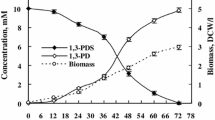Summary
A strain ofAcinetobacter calcoaceticus hydrolysed phenyl-2-octyl carbonate (P-2-OC) by an inducible intracellular hydrolase to phenol and 2-octanol. Washed cells ofA. calcoaceticus grown on yeast extract produced 25% of 2-octanol with 54% enantiomeric excess of the R-enantiomer. The 2-octanol produced was oxidized to 2-octanone and then further degraded. Hydrolytic and oxidative activities, with an optimum pH of 7.0, appeared to be in the supernatant.
Similar content being viewed by others
References
Andreoni V, Baggi G, Bernasconi S, Foglieni C, (1990) Biotransformation of alkyl and aryl carbonates. Microbial degradation. Appl Microbiol Biotechnol 32:414–417
Dale JA, Dull DL, Mosher HS (1969) α-Methoxy-α-trifluoromethyl phenyl acetic acid, a versatile reagent for the determination of enantiomeric composition of alcohols and amines. J Org Chem 34:2543–2549
Fischli A (1980) Chiral building blocks in enantiomer synthesis using enzymatic transformation. In: Eberson L, Seebach D, Vasella A, Fischli A (eds) Modern synthetic methods 1980. Otto Salle, Frankfurt am Main, pp 269–350
Kasai M, Ziffer H, Silverton JV (1985) Enantioselective ester hydrolyses usingRhizopus nigricans: stereoselective synthesis and absolute stereochemistry of (−)-cis and (−)-trans-1-hydroxy-4-methyl-1,2,3,4-tetrahydronaphthalene. Can J Chem 63:1287–1291
Ladner WE, Whitesides GM (1984) Lipase-catalyzed hydrolysis as a route to esters of chiral epoxy alcohols. J Am Chem Soc 106:7250–7251
Langrand G, Baratti J, Buono G, Triantaphylides C (1986) Lipase catalyzed reactions and strategy for alcohol resolution. Tetrahedron Lett 27:29–32
Layne E (1957) Spectrophotometric and turbidimetric methods for measuring protein. III. Biuret method. Methods Enzymol 3:447–454
Maniatis T, Fritsch EF, Sambrook J (1982) Molecular cloning: a laboratory manual. Cold Spring Harbor Laboratory, Cold Spring Harbor, NY
Oberhauser T, Bodenteich M, Faber K, Penn G, Griengl H (1987) Enzymatic resolution of norbornane-type esters. Tetrahedron Lett 43:3931–3944
Oritani T, Yamashita K, Kabuto C (1984) Enantioselectivity of microbial hydrolysis of (±)-decahydro-2-naphthyl acetates. Preparations and absolute configurations of chiral decahydro-2-naphthols. J Org Chem 49:3689–3694
Wang YF, Chen CS, Girdaukas G, Sih CJ (1984) Bifunctional chiral synthons via biochemical methods. 3. Optical purity enhancement in enzymic asymmetric catalysis. J Am Chem Soc 106:3695–3696
Author information
Authors and Affiliations
Rights and permissions
About this article
Cite this article
Andreoni, V., Baggi, G., Bernasconi, S. et al. Biotransformation of alkyl and aryl carbonates: enantioselective hydrolysis. Appl Microbiol Biotechnol 33, 633–636 (1990). https://doi.org/10.1007/BF00604928
Received:
Accepted:
Issue Date:
DOI: https://doi.org/10.1007/BF00604928




